vhost-user协商过程
qemu进程跟spdk target 通过vhost-user协议进行通信,通过共享内存,实现spdk数据直接搬移到guest中。qemu跟spdk的通知机制通过eventfd完成,由于spdk采用polling 模式,因此不需要guest driver发送io submission notification, 后端通过callfd 向guest driver发送中断请求,通知driver处理io
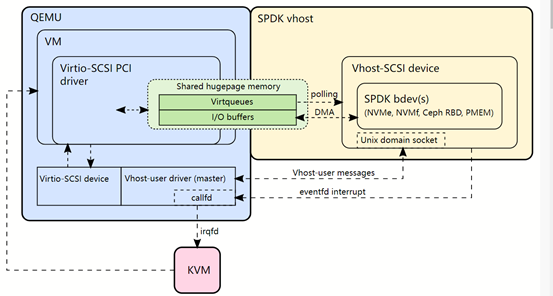
vhost-user协商
qemu通过unix socket跟后端spdk进行通信,qemu chardev有重连机制,在socket 断连之后,会重新发起连接。
1
2
3
4
5
6
7
8
9
10
| host:~# taskset -c 2,3 qemu-system-x86_64 \
--enable-kvm \
-cpu host -smp 2 \
-m 1G -object memory-backend-file,id=mem0,size=1G,mem-path=/dev/hugepages,share=on -numa node,memdev=mem0 \
-drive file=guest_os_image.qcow2,if=none,id=disk \
-device ide-hd,drive=disk,bootindex=0 \
-chardev socket,id=spdk_vhost_scsi0,path=/var/tmp/vhost.0 \
-device vhost-user-scsi-pci,id=scsi0,chardev=spdk_vhost_scsi0,num_queues=2 \
-chardev socket,id=spdk_vhost_blk0,path=/var/tmp/vhost.1 \
-device vhost-user-blk-pci,chardev=spdk_vhost_blk0,num-queues=2
|
vhost-user-blk 协商过程可能发生在设备初始化过程中或者sock open事件之后。协商在vhost_user_blk_connect调用。
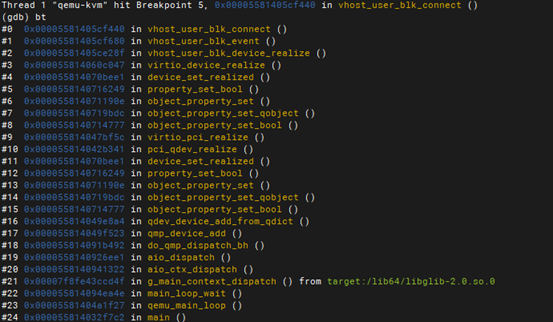
关键函数vhost_dev_init中
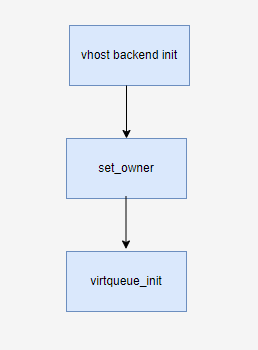
vhost backend init主要是初始化vhost protocol 协议,VHOST_USER_F_PROTOCOL_FEATURES 是virtio协议中定义用来进行协议特性的标志位,用来初始化设备是否支持多队列以及最大队列数,内存slot个数等,这一位对于guest而言是不可见,protocol 特性对于guest而言也是不可见的,guest driver不需要关心这些。
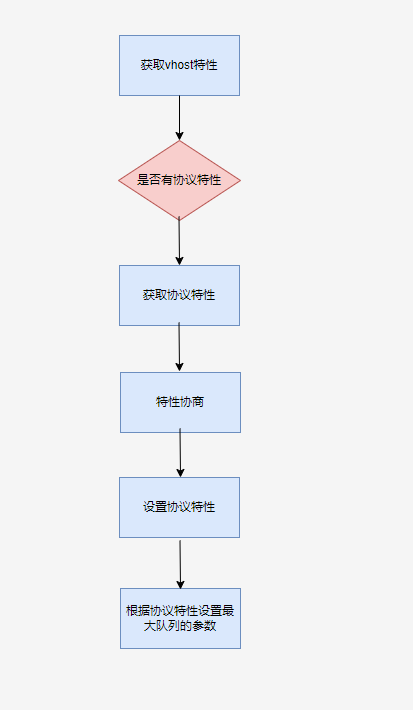
对应spdk里面的log:

set_owner对于vhost_user 是直接返回ok
再接下来的动作是获取设备的特性,对vitqueue 初始化,设置vring_call, 这个是vhost-user后端通知guest事件的fd, 初始化时设置的是masked_notifier, 即这个时候是不能发送中断到guest。
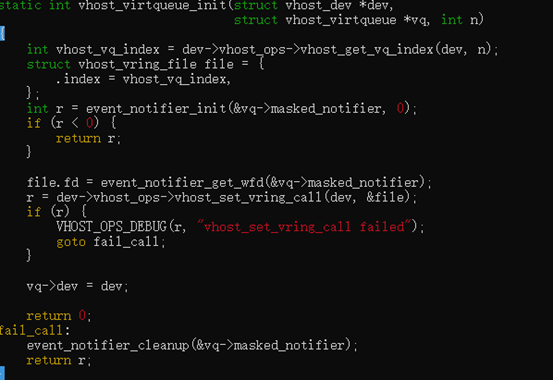
接下来的操作是获取blk 配置信息,包括磁盘容量,seg_max, size_max 队列数等。
接下来是vhost_user_blk_start, 这个动作触发的时机guest driver跟device完成probe之后,通过设置status 为VIRTIO_CONFIG_S_DRIVER_OK触发,status变量是控制device一个关键变量,设备的start跟stop都是通过它来实现。

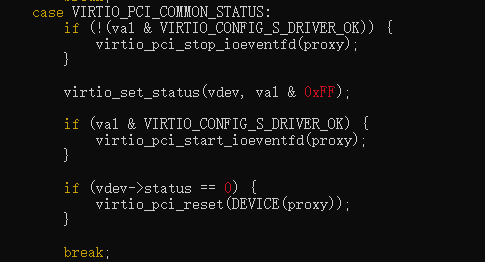
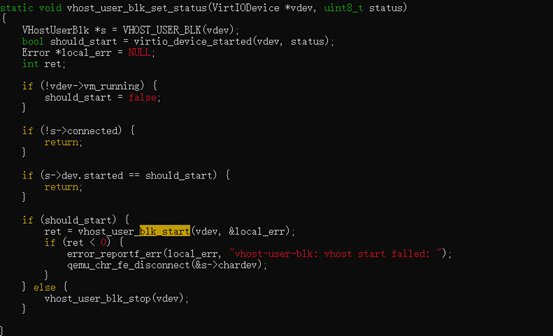
vhost_user_blk_start主要流程, 设置host, guest notifier 分别对应guest kick 后端的通知和后端向guest发irq中断通知,设置inflight io,这个特性主要是保存pending io,方便迁移的时候回滚,启动vhost_dev_start , 这个是关键函数,最后是完成vring call设置。
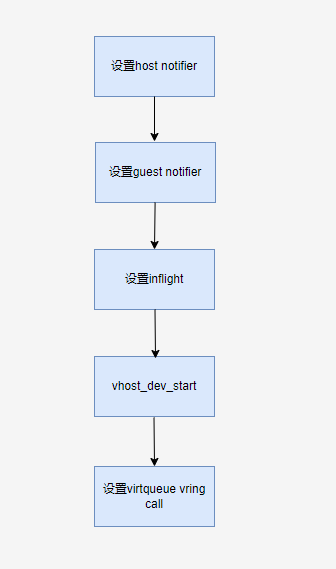
vhost_dev_start 首先设置vhost features, 然后设置mem_table将mem信息传给spdk后端,然后设置virtqueue相关参数,如queue size, vring base, vring base addr等
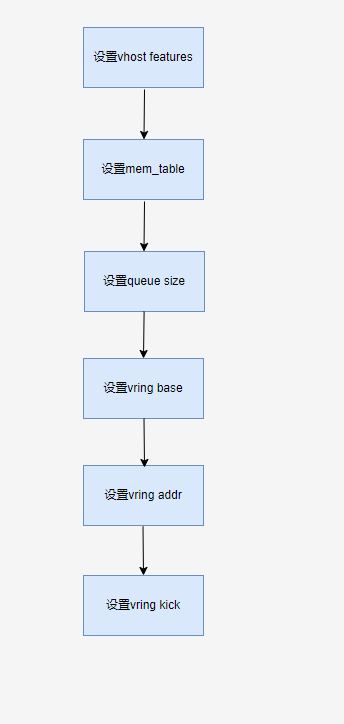
对应spdk侧打印log
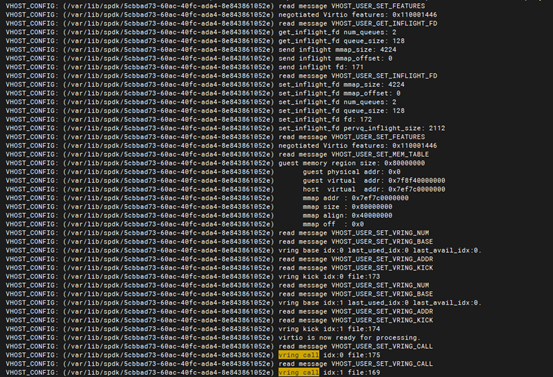
vhost-user 重连
vhost-user 重连是qemu chardev 实现的功能,在链接过程中进行检查,如果发现有问题,就会进行超时重新链接,超时时间即reconnect参数指定。blk_realize_connect 在发起连接之前,首先通过qemu_chr_fe_wait_connected 确保socket已连接,然后再尝试连接。等待socket变成connected这个状态是同步, 如果这个时候后端服务没有起来或者没有创建磁盘,那么虚机启动将卡住。
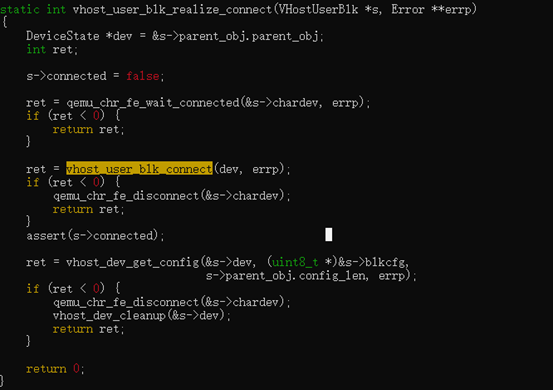
过程栈信息:
1
2
3
4
5
6
7
8
9
10
11
12
13
14
15
16
17
18
19
| tcp_chr_wait_connected ()
vhost_user_blk_device_realize ()
virtio_device_realize ()
device_set_realized ()
property_set_bool ()
object_property_set ()
object_property_set_qobject ()
object_property_set_bool ()
virtio_pci_realize ()
pci_qdev_realize ()
device_set_realized ()
property_set_bool ()
object_property_set ()
object_property_set_qobject ()
object_property_set_bool ()
qdev_device_add_from_qdict ()
qmp_x_exit_preconfig ()
qemu_init ()
main ()
|
1
2
3
4
5
6
7
8
9
10
11
12
13
14
15
16
17
18
19
20
21
22
23
24
25
26
27
28
29
30
31
32
33
34
35
36
| static void check_report_connect_error(Chardev *chr,
Error *err)
{
SocketChardev *s = SOCKET_CHARDEV(chr);
if (!s->connect_err_reported) {
error_reportf_err(err,
"Unable to connect character device %s: ",
chr->label);
s->connect_err_reported = true;
} else {
error_free(err);
}
qemu_chr_socket_restart_timer(chr);
}
static void qemu_chr_socket_connected(QIOTask *task, void *opaque)
{
QIOChannelSocket *sioc = QIO_CHANNEL_SOCKET(qio_task_get_source(task));
Chardev *chr = CHARDEV(opaque);
SocketChardev *s = SOCKET_CHARDEV(chr);
Error *err = NULL;
s->connect_task = NULL;
if (qio_task_propagate_error(task, &err)) {
tcp_chr_change_state(s, TCP_CHARDEV_STATE_DISCONNECTED);
if (s->registered_yank) {
yank_unregister_function(CHARDEV_YANK_INSTANCE(chr->label),
char_socket_yank_iochannel,
QIO_CHANNEL(sioc));
}
check_report_connect_error(chr, err);
goto cleanup;
}
s->connect_err_reported = false;
tcp_chr_new_client(chr, sioc);
cleanup:
object_unref(OBJECT(sioc));
}
|
另外在socket 断链之后也会进行超时重连
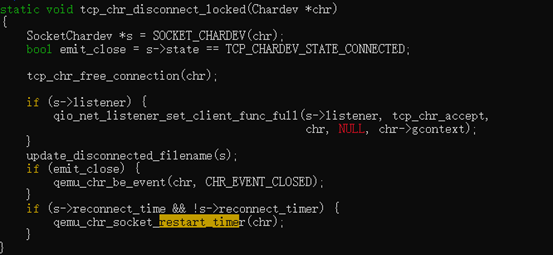
socket断链之后发起超时重连

超时发起重新连接,如果检查到连接出错,会重新发起超时重连
















